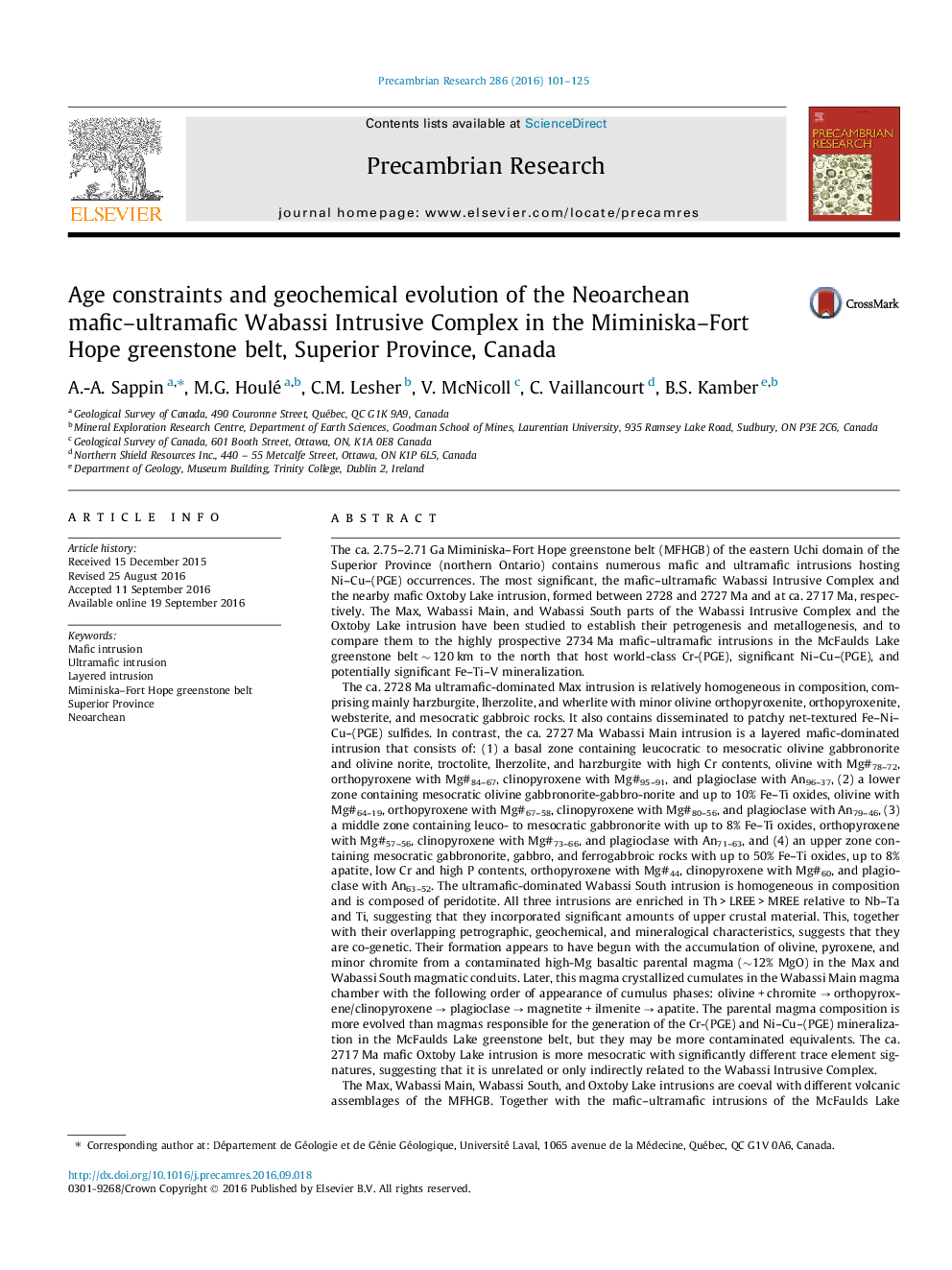| کد مقاله | کد نشریه | سال انتشار | مقاله انگلیسی | نسخه تمام متن |
|---|---|---|---|---|
| 4722298 | 1639589 | 2016 | 25 صفحه PDF | دانلود رایگان |

• Max, Wabassi Main, and Wabassi South intrusions form the Wabassi Intrusive Complex.
• Wabassi Intrusive Complex formed between 2728 and 2727 Ma.
• All parental magmas are basaltic (up to ∼12% MgO).
• Max intrusion may be the most prospective area for Ni–Cu–(PGE) exploration.
• Oxtoby Lake intrusion younger (2717 Ma) and unrelated to Wabassi Intrusive Complex.
The ca. 2.75–2.71 Ga Miminiska–Fort Hope greenstone belt (MFHGB) of the eastern Uchi domain of the Superior Province (northern Ontario) contains numerous mafic and ultramafic intrusions hosting Ni–Cu–(PGE) occurrences. The most significant, the mafic–ultramafic Wabassi Intrusive Complex and the nearby mafic Oxtoby Lake intrusion, formed between 2728 and 2727 Ma and at ca. 2717 Ma, respectively. The Max, Wabassi Main, and Wabassi South parts of the Wabassi Intrusive Complex and the Oxtoby Lake intrusion have been studied to establish their petrogenesis and metallogenesis, and to compare them to the highly prospective 2734 Ma mafic–ultramafic intrusions in the McFaulds Lake greenstone belt ∼ 120 km to the north that host world-class Cr-(PGE), significant Ni–Cu–(PGE), and potentially significant Fe–Ti–V mineralization.The ca. 2728 Ma ultramafic-dominated Max intrusion is relatively homogeneous in composition, comprising mainly harzburgite, lherzolite, and wherlite with minor olivine orthopyroxenite, orthopyroxenite, websterite, and mesocratic gabbroic rocks. It also contains disseminated to patchy net-textured Fe–Ni–Cu–(PGE) sulfides. In contrast, the ca. 2727 Ma Wabassi Main intrusion is a layered mafic-dominated intrusion that consists of: (1) a basal zone containing leucocratic to mesocratic olivine gabbronorite and olivine norite, troctolite, lherzolite, and harzburgite with high Cr contents, olivine with Mg#78–72, orthopyroxene with Mg#84–67, clinopyroxene with Mg#95–91, and plagioclase with An96–37, (2) a lower zone containing mesocratic olivine gabbronorite-gabbro-norite and up to 10% Fe–Ti oxides, olivine with Mg#64–19, orthopyroxene with Mg#67–58, clinopyroxene with Mg#80–56, and plagioclase with An79–46, (3) a middle zone containing leuco- to mesocratic gabbronorite with up to 8% Fe–Ti oxides, orthopyroxene with Mg#57–56, clinopyroxene with Mg#73–66, and plagioclase with An71–63, and (4) an upper zone containing mesocratic gabbronorite, gabbro, and ferrogabbroic rocks with up to 50% Fe–Ti oxides, up to 8% apatite, low Cr and high P contents, orthopyroxene with Mg#44, clinopyroxene with Mg#60, and plagioclase with An63–52. The ultramafic-dominated Wabassi South intrusion is homogeneous in composition and is composed of peridotite. All three intrusions are enriched in Th > LREE > MREE relative to Nb–Ta and Ti, suggesting that they incorporated significant amounts of upper crustal material. This, together with their overlapping petrographic, geochemical, and mineralogical characteristics, suggests that they are co-genetic. Their formation appears to have begun with the accumulation of olivine, pyroxene, and minor chromite from a contaminated high-Mg basaltic parental magma (∼12% MgO) in the Max and Wabassi South magmatic conduits. Later, this magma crystallized cumulates in the Wabassi Main magma chamber with the following order of appearance of cumulus phases: olivine + chromite → orthopyroxene/clinopyroxene → plagioclase → magnetite + ilmenite → apatite. The parental magma composition is more evolved than magmas responsible for the generation of the Cr-(PGE) and Ni–Cu–(PGE) mineralization in the McFaulds Lake greenstone belt, but they may be more contaminated equivalents. The ca. 2717 Ma mafic Oxtoby Lake intrusion is more mesocratic with significantly different trace element signatures, suggesting that it is unrelated or only indirectly related to the Wabassi Intrusive Complex.The Max, Wabassi Main, Wabassi South, and Oxtoby Lake intrusions are coeval with different volcanic assemblages of the MFHGB. Together with the mafic–ultramafic intrusions of the McFaulds Lake greenstone belt, they probably represent the remnants of an Archean large igneous complex that was emplaced within the northern Superior Province between ca. 2.88 and 2.70 Ga. Among these four intrusions, Max may be the most prospective for Ni–Cu–(PGE) mineralization. The high abundance of primitive ultramafic rocks suggests that it was an open, dynamic system that accumulated olivine and pyroxene, and the trace element signature is consistent with incorporation of significant amounts of upper crustal material, permissive to the formation of Ni–Cu–(PGE) mineralization.
Journal: Precambrian Research - Volume 286, November 2016, Pages 101–125